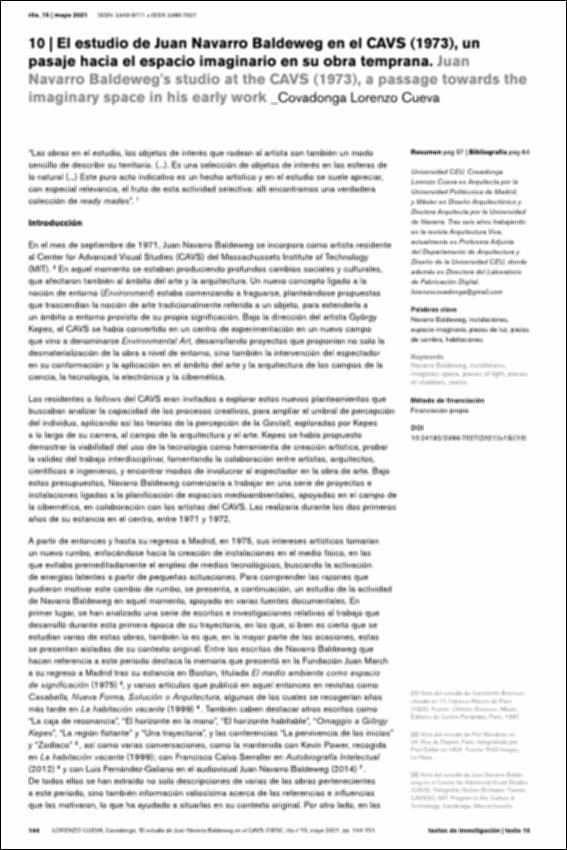Please use this identifier to cite or link to this item:
http://hdl.handle.net/10637/15631El estudio de Juan Navarro Baldeweg en el CAVS (1973), un pasaje hacia el espacio imaginario en su obra temprana.
| Title: | El estudio de Juan Navarro Baldeweg en el CAVS (1973), un pasaje hacia el espacio imaginario en su obra temprana. Juan Navarro Baldeweg's studio at the CAVS (1973), a passage towards the imaginary space in his early work |
| Authors : | Lorenzo Cueva, Covadonga |
| Keywords: | Navarro Baldeweg; Instalaciones; Espacio imaginario; Piezas de luz; Piezas de sombra; Habitaciones; Installations; Imaginary space; Pieces of light; Pieces of shadows; Rooms |
| Publisher: | Redfundamentos |
| Citation: | Lorenzo Cueva, C. (2021). El estudio de Juan Navarro Baldeweg en el CAVS (1973). Revista rita, 15, 144-151. |
| Abstract: | En la obra que realizó Juan Navarro Baldeweg en los primeros años de su trayectoria, durante su estancia en el Center for Advanced Visual Studies (CAVS) del Massachussets Institute of Technology (MIT), entre 1971 y 1975, se encuentran implícitos los principios que han guiado su modo de trabajar a lo largo de su vida. Con el fin de aportar algo más de luz sobre su obra temprana, el artículo plantea el análisis de la colección de obras, piezas y objetos cotidianos presentes en el estudio que ocupó en el CAVS durante aquellos años. Todas ellas constituyen el registro de su espacio imaginario, un ámbito mental propio del artista en el que se gestan las obras y donde se recogen sus referencias e intereses. Así, su estudio de trabajo se concibe como un pasaje, un ámbito de transición entre su espacio imaginario o de ideación y el medio físico sobre el que proyecta su obra, aportando una información valiosísima para profundizar sobre los presupuestos artísticos que guiaron su trabajo en esta primera etapa de su trayectoria profesional. In the work carried out by Juan Navarro Baldeweg in the early years of his career, during his stay at the Center for Advanced Visual Studies (CAVS) of the Massachusetts Institute of Technology (MIT), between 1971 y 1975, it is possible to find out the principles that have guided his way of working throughout his life. In order to shed some light on his early work, the article presents the analysis of the collection of works, pieces and common objects shown in the studio that he occupied at the CAVS during those years. All of them are the record of his imaginary space, a mental realm of the artist in which the works are conceived and where the references and interests are collected. Thereby, his work studio is conceived as a passage, a transitional space between his imaginary or ideation space and the physical environment on which he creates his work, providing invaluable |
| URI: | http://hdl.handle.net/10637/15631 |
| Rights : | http://creativecommons.org/licenses/by-nc-nd/4.0/deed.es |
| ISSN: | 2340-9711 |
| Language: | en |
| Issue Date: | May-2021 |
| Center : | Universidad San Pablo-CEU |
| Appears in Collections: | Escuela de Politécnica Superior |
Items in DSpace are protected by copyright, with all rights reserved, unless otherwise indicated.


